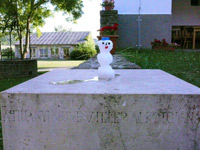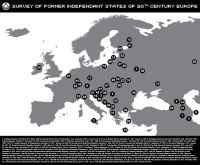 Monthly one videoartist will be invited.
Monthly one videoartist will be invited.
The aim of this program is to promote hungarian and external video artists and to help video art to became part of the art commerce in Hungary too.
First invited artist: Endre Koronczi
Read the rest of this entry »
(the laboratory of the new concept of the art colony)
 Opening: 30 September 2008, Tuesday 7 pm
Opening: 30 September 2008, Tuesday 7 pm
Az intermédia szokásos nyári művésztelepe kiheverte azt a krízist amelyet az okozott, hogy Halász Pétert többé már nem lehet meghívni. A kötelező nyári művészelep koncepciója kiürült, majd megújult, és magát a meghívást tűzte ki céljául: a 33 éves korában elhunyt Gordon Matta-Clark FOOD projektjének emlékére – és azt szerényen comidas criollas-nak nevezve – a művésztelep két hetének minden délutánját főzéssel és az estéket annak az elfogyasztásával töltse vendégei társaságában.
http://tranzit.blog.hu/2008/08/02/food_1
Read the rest of this entry »
Prezentációk és közös portfólió készítés

Read the rest of this entry »
Fragment #6: Labour Day
 Opening: 7 pm 29th April 2008
Opening: 7 pm 29th April 2008
The question we put to ourselves in the autumn of 2006 was a relatively simple one: What has happened in the twenty years since the fall of the Iron Curtain to us, to the artistic imagination, to society? How are we to relate today to the twenty-year period of transformation that we were, and still are, part of? Read the rest of this entry »
Exposition of Arts and Techniques applied to Modern Life a project by Société Réaliste
 Opening: 7 pm 4th April 2008
Opening: 7 pm 4th April 2008
Culture States: Exposition of Arts and Techniques applied to Modern Life takes its subtitle from the historical Exposition Internationale des Arts et Techniques appliquées à la Vie Moderne, held in 1937 in Paris. This project consists in designing a complete “World Fair”, based on the very principle of the 1937’s one: pavilions attributed to recognized territories and supposed to exemplify the variety of cultures. This 1937’s fair has been the most spectacular example of the relation between Culture and Nation, from the confrontation between the Nazi and the Soviet pavilions to the display of the imperialist cultural conceptions of France or UK through colonial pavilions. Seventy years after this key-moment, what is the relation between political and cultural entities in nowadays Europe? The main shift of Culture States is that, on the contrary of historical world fairs, this one does not take nation-states as a territorial unit. In this project, pavilions are dedicated to former independant countries, that appeared and disappeared during the 20th century.
Read the rest of this entry »
 Monthly one videoartist will be invited.
Monthly one videoartist will be invited.
 Opening: 30 September 2008, Tuesday 7 pm
Opening: 30 September 2008, Tuesday 7 pm
 Opening: 7 pm 29th April 2008
Opening: 7 pm 29th April 2008 Opening: 7 pm 4th April 2008
Opening: 7 pm 4th April 2008